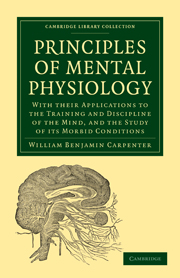 Principles of Mental Physiology
Principles of Mental Physiology Book contents
- Frontmatter
- PREFACE
- Contents
- BOOK I GENERAL PHYSIOLOGY
- BOOK II SPECIAL PHYSIOLOGY
- CHAPTER X OF MEMORY
- CHAPTER XI OF COMMON SENSE
- CHAPTER XII OF IMAGINATION
- CHAPTER XIII OF UNCONSCIOUS CEREBRATION
- CHAPTER XIV OF REVERIE AND ABSTRACTION:—ELECTRO-BIOLOGY
- CHAPTER XV OF SLEEP, DREAMING, AND SOMNAMBULISM
- CHAPTER XVI OF MESMEBISM AND SPIRITUALISM
- CHAPTER XVII OF INTOXICATION AND DELIRIUM
- CHAPTER XVIII OF INSANITY
- CHAPTER XIX INFLUENCE OF MENTAL STATES ON THE ORGANIC FUNCTIONS
- CHAPTER XX OF MIND AND WILL IN NATURE
- APPENDIX. DR. FERRIER'S EXPERIMENTAL RESEARCHES ON THE BRAIN
- INDEX
CHAPTER XI - OF COMMON SENSE
Published online by Cambridge University Press: 29 August 2010
- Frontmatter
- PREFACE
- Contents
- BOOK I GENERAL PHYSIOLOGY
- BOOK II SPECIAL PHYSIOLOGY
- CHAPTER X OF MEMORY
- CHAPTER XI OF COMMON SENSE
- CHAPTER XII OF IMAGINATION
- CHAPTER XIII OF UNCONSCIOUS CEREBRATION
- CHAPTER XIV OF REVERIE AND ABSTRACTION:—ELECTRO-BIOLOGY
- CHAPTER XV OF SLEEP, DREAMING, AND SOMNAMBULISM
- CHAPTER XVI OF MESMEBISM AND SPIRITUALISM
- CHAPTER XVII OF INTOXICATION AND DELIRIUM
- CHAPTER XVIII OF INSANITY
- CHAPTER XIX INFLUENCE OF MENTAL STATES ON THE ORGANIC FUNCTIONS
- CHAPTER XX OF MIND AND WILL IN NATURE
- APPENDIX. DR. FERRIER'S EXPERIMENTAL RESEARCHES ON THE BRAIN
- INDEX
Summary
376. The term “Common Sense” has been used in a vast variety of acceptations, of which a most learned collection will be found in Sir William Hamilton's supplemental note to Dr. Reid's Essay; but it will be convenient here to use that of Dr. Reid himself, who says that the office of Common Sense, or the “first degree of reason,” is to “judge of things self-evident,” as contrasted with the office of “the second degree of reason” (or Ratiocination), which is “to draw conclusions that are not self-evident from those that are.” —The distinction between “Common Sense,” and “Ratiocination” or the “discursive power,” is regarded by Sir William Hamilton as equivalent to that which the Greek philosophers meant to indicate by the terms voÛs and hiavoia; and our colloquial use of the former, as corresponding to that cultivated Common Sense which is often distinguished as “good sense,” is thereby justified.—There are, however, two principal forms of this capacity, which it is desirable clearly to distinguish.
377. The first is what the philosopher means by Common Sense, when he attributes to it the formation of those original convictions or ultimate beliefs, which cannot be resolved into simpler elements, and which are accepted by every normally-constituted human being as direct cognitions of his own mental states (§ 199). It might, indeed, be maintained that this “necessary” acceptance of propositions which only need to be intelligibly stated to command unhesitating and universal assent, cannot be rightly termed an act of judgment.
- Type
- Chapter
- Information
- Principles of Mental PhysiologyWith their Applications to the Training and Discipline of the Mind, and the Study of its Morbid Conditions, pp. 471 - 486Publisher: Cambridge University PressPrint publication year: 2009First published in: 1874


